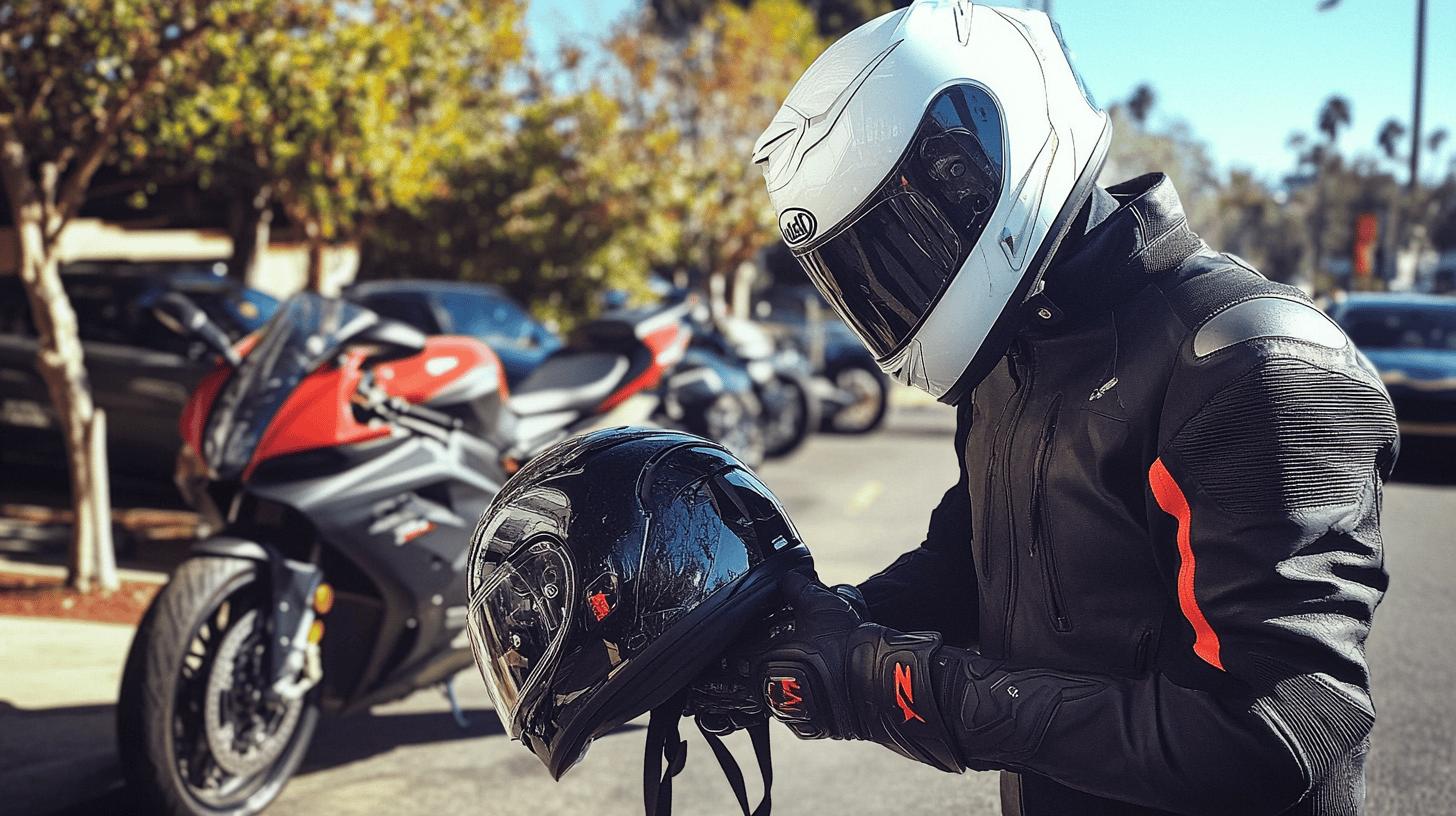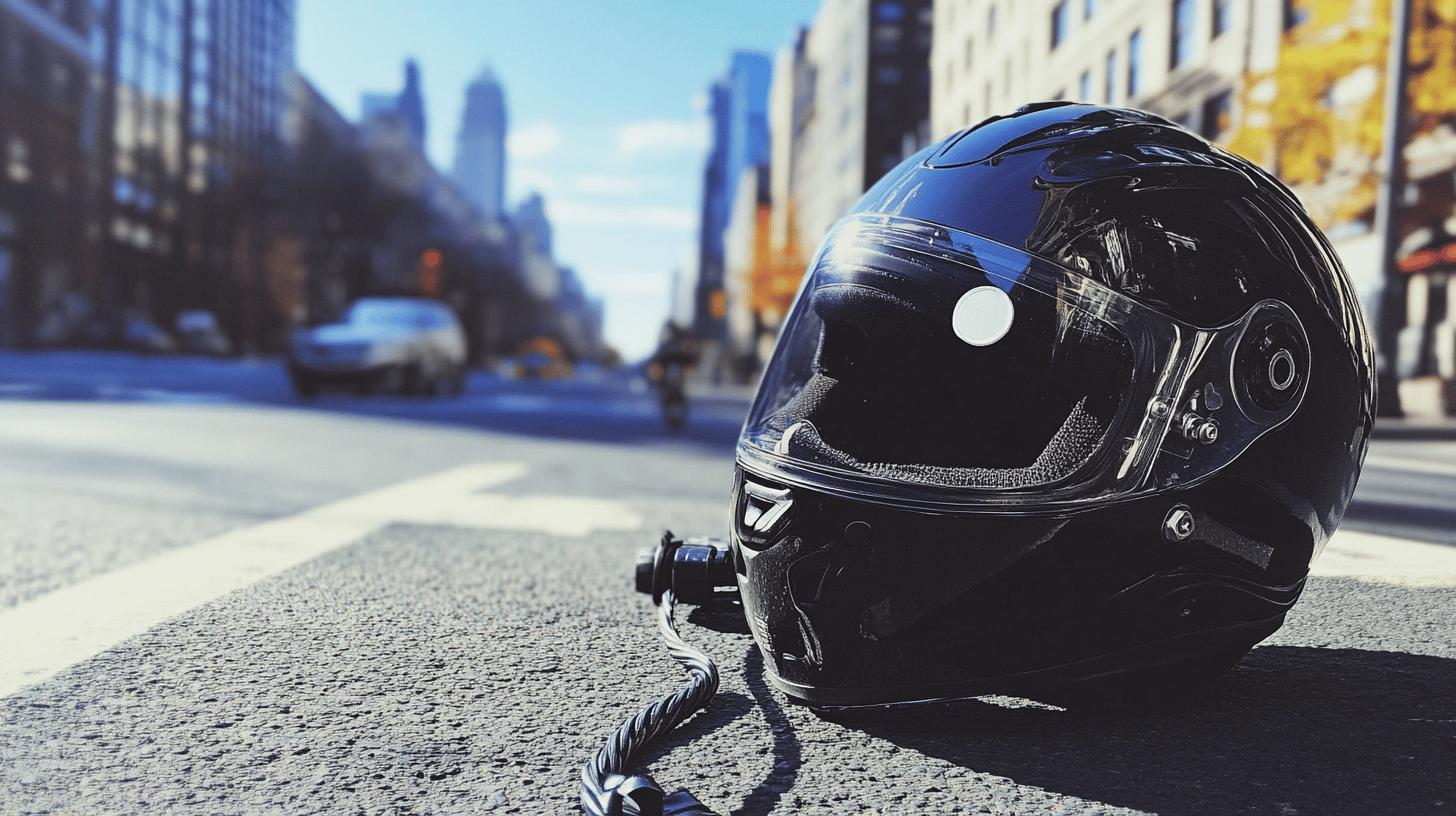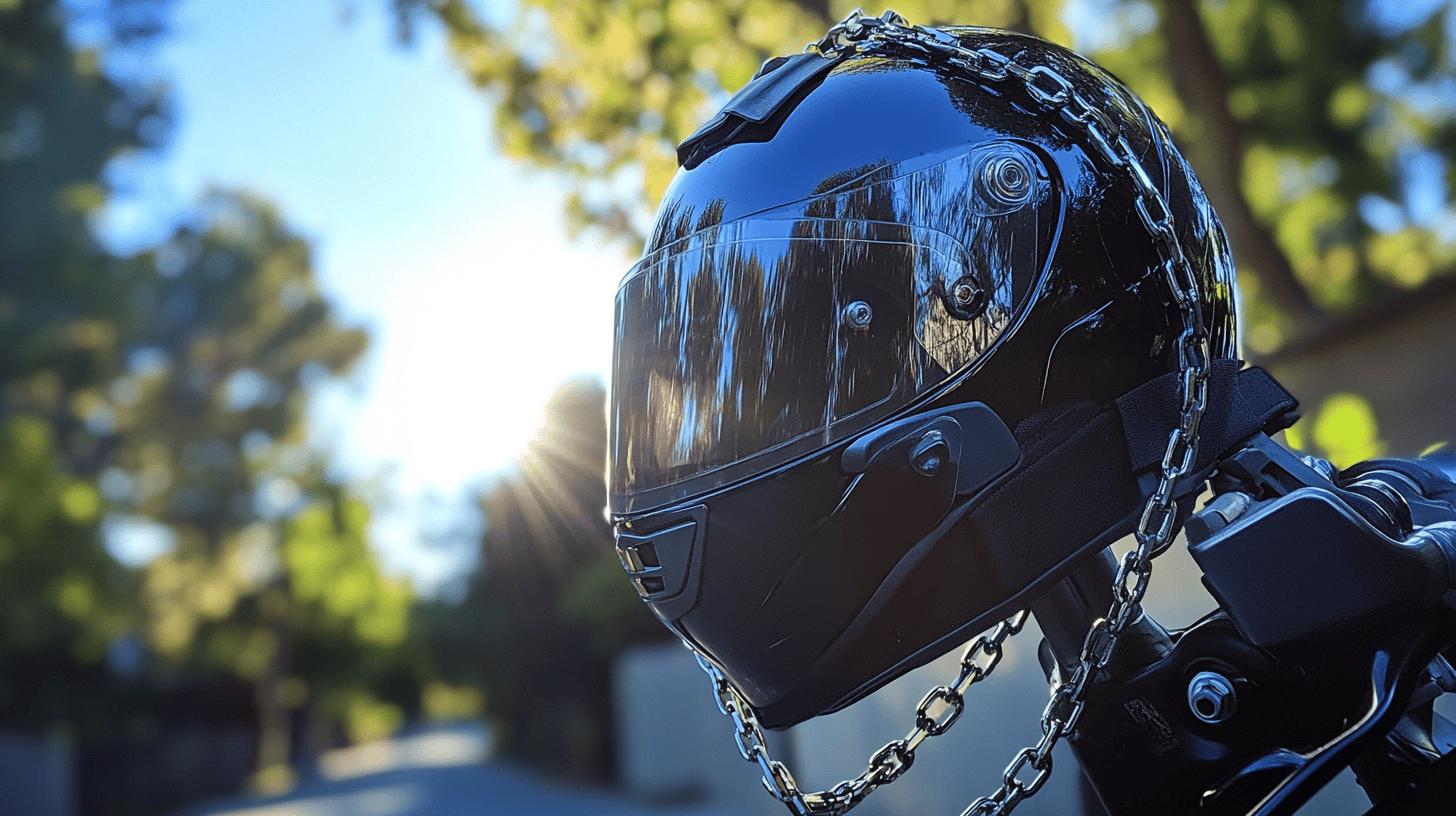Ever fret about leaving your helmet unattended while running errands on your motorcycle? With motorcycle theft on the rise, ensuring your gear stays intact is more crucial than ever. Investing in a reliable helmet lock can be a game-changer, offering peace of mind and safeguarding your equipment.
From bolt locks to combination locks, the market offers varied solutions for securing your helmet to your bike, all without breaking the bank. In this article, we'll delve into the mechanics of helmet locking devices and guide you through securing your helmet effectively and confidently.
Understanding Helmet Locking Devices

Motorcycle helmet locks play a crucial role in preventing theft by securing the helmet to the bike's frame. Without a lock, helmets are vulnerable to theft, especially in urban areas where motorcycles are parked frequently.
The convenience of a helmet lock means riders can leave their helmet with the bike instead of carrying it everywhere, which is particularly useful when running errands or socializing. By using a lock, riders not only protect their helmet but also avoid the hassle of constantly managing an unwieldy piece of equipment.
There are several types of helmet locks available on the market, each offering unique benefits. Bolt locks are traditional and use a key mechanism to secure the helmet, providing a straightforward and reliable option. Carabiner locks, inspired by climbing gear, offer a combination lock feature that reduces the risk of losing keys and adds versatility.
Cable locks, known for their affordability, use a threaded steel cable loop to attach the helmet to the bike, making them a popular choice for budget-conscious riders. Combination locks eliminate the need for keys altogether, using a numeric code to secure the helmet, and are designed for ease of use with added security.
-
Bolt Locks: Traditional keyed security, reliable and easy to use.
-
Carabiner Locks: Combines versatility with a combination mechanism.
-
Cable Locks: Affordable, using a steel cable loop for attachment.
- Combination Locks: Key-free security with numeric code.
Helmet locks are generally priced under $30, making them an economical choice for enhancing security. Most locks are designed to accommodate both half and full-face helmets, ensuring widespread compatibility across different helmet styles.
This adaptability allows riders to choose a lock that best fits their specific needs without breaking the bank, ensuring a secure and convenient solution for all motorcycle enthusiasts.
Step-by-Step Guide to Locking Your Helmet to a Motorcycle

Locking your helmet securely to your motorcycle is a crucial step in preventing theft and ensuring peace of mind. Following the correct procedure not only protects your gear but also frees you from the burden of carrying your helmet everywhere. It's important to understand the steps involved to make sure the helmet is properly secured and not easily detachable by potential thieves.
- Select an Appropriate Location
Choose a spot on your motorcycle where the helmet will not obstruct your control or get in the way, such as the handlebars, mirror, or a dedicated helmet hook. Ensure the location is sturdy enough to hold the weight of the helmet.
- Position the Helmet
Place the helmet in the chosen spot, ensuring it rests securely and is stable. This positioning will ensure it doesn't swing or move excessively, which can cause damage or create opportunities for theft.
- Thread the Lock Through the Helmet
Pass the lock through the helmet's chin strap or D-ring. If your motorcycle has an under-seat lock, thread the retention strap through the hook before replacing the seat for additional security.
- Secure the Lock to the Motorcycle
Attach the lock to a solid part of the motorcycle, such as the frame or a designated locking point. This ensures the helmet remains attached to the bike and deters theft attempts.
- Engage the Locking Mechanism
Lock the device securely by using a key, combination, or any other security feature it may have. Confirm that the locking mechanism is fully engaged and not easily tampered with.
- Check for Potential Movement
Test the helmet and lock by gently tugging on them to confirm they are secure. Make sure the lock is tight and that the helmet cannot be removed without disengaging the lock.
- Verify Security Before Leaving
Double-check the lock and helmet placement to ensure everything is secure. A final assessment assures you that the helmet is protected while you're away from the motorcycle.
By following these steps, you can confidently leave your helmet with your motorcycle, knowing it's secured. Regularly inspecting the lock's condition and functionality is vital for continued security. This vigilance ensures that you can trust your gear to stay put, allowing you to focus on the ride ahead.
Alternative Helmet Locking Methods

Repurposing unconventional items can be a viable strategy for securing a helmet to a motorcycle. A gunlock, commonly used for firearms, can double as a helmet lock. If you already own one, this option becomes particularly cost-effective. Similarly, bicycle cable locks offer a budget-friendly solution, although they may not provide the same level of security as dedicated helmet locks.
These locks are typically lighter and more portable, making them appealing for riders who prioritize convenience. However, their thinner cables can be more susceptible to cutting, presenting a potential risk in areas with higher theft concerns.
-
Gunlocks: Cost-effective if already owned, but may require additional components for optimal security.
-
Bicycle Cable Locks: Affordable and lightweight, but less robust against cutting tools.
-
Chain Locks: Versatile and strong, but bulkier and may require careful placement to avoid damaging the helmet.
Incorporating built-in locks found on some motorcycles can enhance security while providing seamless integration. Models like the Honda CRF250L Rally and Suzuki GSX-S750 feature built-in hooks under the seat, offering an unobtrusive way to secure helmets.
This method is particularly convenient for riders who wish to avoid carrying separate locking devices. By utilizing these built-in features, motorcyclists can enjoy the dual benefits of security and convenience, ensuring their helmets remain protected without the need for additional gear.
Tips to Prevent Helmet Theft

Motorcycle theft rates tend to spike in warmer months, with over 54,736 thefts reported in 2022. To mitigate the risk of helmet theft, the most effective strategy is to remove the helmet and take it with you when leaving the motorcycle unattended. This method eliminates any chance of theft, as the helmet remains in your possession.
For those who prefer to leave their helmet with the bike, using high-quality locks is crucial.
-
Invest in high-quality locks: Opt for U-locks or heavy-duty chain locks made from hardened steel for maximum security.
-
Choose parking spots wisely: Park in well-lit, crowded areas to deter thieves.
-
Use visible deterrents: Brightly colored locks or covers can discourage potential theft.
-
Secure the helmet through multiple points: Pass the lock through both the chin strap and a sturdy part of the motorcycle.
-
Consider adding an alarm: Helmet alarms can alert you to any tampering when you're nearby.
Heavy-duty locks, such as those made from hardened steel, offer superior protection against theft attempts. These locks are resistant to cutting and tampering, making them a strong deterrent for thieves. Their robustness provides peace of mind, ensuring that the helmet remains secure even in high-risk areas.
Maintaining vigilance is key to preventing helmet theft. Regularly check the lock’s condition to ensure it remains in full working order. Over time, locks can wear down or become damaged, compromising their efficacy. By conducting routine inspections and addressing any issues promptly, riders can maintain the security of their helmets and avoid potential theft.
Helmet Lock Accessories and Enhancements

Nylon ball bags and lockable helmet cases are effective accessories for enhancing helmet security. A nylon ball bag shields against rain better than a cloth sock, ensuring the helmet remains dry and intact.
Similarly, lockable helmet cases provide a robust barrier against theft and environmental elements. These accessories serve dual purposes: protecting the helmet from weather damage and deterring opportunistic theft by making unauthorized access more challenging.
-
Demit Helmet Bag: Features a 2mm steel cable lining to prevent slashing and includes a 5mm steel cable to anchor the bag to the motorcycle, enhancing security.
-
Waterproof Helmet Covers: Designed to fit snugly over helmets, providing protection against rain and dust, ensuring the helmet's condition remains optimal.
-
Lockable Helmet Cases: Offer a hard-shell protection solution that can be secured to the motorcycle, protecting the helmet from theft and damage.
These accessories significantly improve motorcycle gear security, especially in unpredictable weather conditions. By incorporating such enhancements, riders not only safeguard their helmets but also enjoy the convenience of not having to constantly carry them.
The security features in these products, like steel cable linings and waterproof materials, provide both peace of mind and practical advantages, ensuring helmets remain safe and dry, regardless of the riding environment.
Final Words
Exploring how to lock a helmet to a motorcycle reveals numerous methods for safeguarding your gear. From understanding different lock types to detailed instructions and alternative methods, riders have options aplenty.
Tips for theft prevention further bolster security. Accessories and enhancements like the Demit helmet bag offer added protection and convenience. Utilizing these strategies ensures peace of mind, allowing riders to focus on the joy of their journey.
FAQ
Q: Is there a way to lock your helmet to your motorcycle?
A: A helmet lock connects to both the helmet and motorcycle frame, using bolt locks, carabiner locks, cable locks, or combination locks to secure the helmet.
Q: How do you lock a helmet to a Harley Davidson motorcycle?
A: With Harley Davidson, using the bike-specific lock or cable locks through helmet straps ensures a secure attachment to the motorcycle.
Q: How do you lock a helmet strap?
A: Thread the helmet strap through the lock's loop or fastening mechanism to securely anchor it to the motorcycle or locking device.
Q: What is a universal motorcycle helmet lock?
A: A universal lock is versatile, accommodating different helmet types and connecting to various motorcycle parts to prevent theft.
Q: How do you put a lock on a helmet?
A: Insert the lock mechanism through the helmet's chin strap or D-ring, securing it to the motorcycle frame or designated lock area.
Q: What are alternative helmet locking methods?
A: Alternatives include using gunlocks, bicycle cable locks, and built-in motorcycle hooks under seats for added convenience and affordability.
Q: How do you latch a motorcycle helmet?
A: Align and fasten the helmet's chin strap through the buckle, ensuring a snug fit to keep the helmet securely on the rider's head.
Q: How can helmets be stored or secured with accessories?
A: Hope accessories include the Demit helmet bag with steel cable lining, nylon bags for rain protection, and lockable cases for added security.

Brad Mitchell is a seasoned motorcycle enthusiast with over 16 years of riding experience. He’s spent countless hours on the open road, particularly favoring scenic routes aboard his trusted Harley-Davidson. Brad’s laid-back approach to life and riding gives him a unique perspective on motorcycle gear and safety, which he shares through his in-depth reviews and expert advice on ProtectiveGearz.



